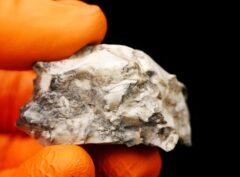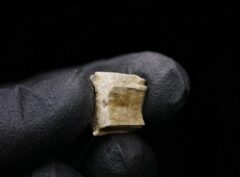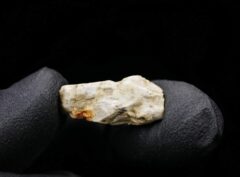Classification: Achondrite, Aubrite S-low, W-low
Place/Time: 2022 in Mali
Mass: 17kg
History: This meteorite was found in late March 2022 in Mali, about 10 km to the southwest from Sebkha el Melah and 245 km southeast of Taoudenni, by Sahrawi meteorite hunters. The total recovered amount was approximately 17 kg. Bachir Salek obtained 12.5 kg, including the main mass, which weighs 3550 g.
Physical: This meteorite consists primarily of clusters of coarse, interlocking enstatite crystals with a pegmatitic texture. Individual crystals are cm-sized, many showing distinct cleavage planes and traces. Some enstatite crystals are milky-white in color, while a few are colorless translucent to transparent and gemmy. The enstatite crystals separate from the clusters easily, and the largest single crystal weighed 45 grams and was approximately 5 cm long and 2 cm wide. There are also scattered dark-colored patches on some of the crystals. Significant amounts of smooth cream-colored to white fusion crust are visible, although some fusion crust is dark-colored. No vesicles are present. The meteorite appears to be unbrecciated.
Petrography: (A. Ross and C. Agee, UNM) Electron microprobe analyses and reflected light microscopy show that enstatite makes up approximately 98% of this meteorite. Scattered small diopside grains were detected. A single olivine grain was found in the sample microprobe mount. Small grains of kamacite, taenite, schreibersite, Ti-troilite, troilite, and daubreélite were the only accessory opaques observed. No other sulfides were detected. No feldspar was found in the microprobe mount. Geochem: (A. Ross, UNM) Enstatite Fs0.0±0.0Wo0.9±0.1, n=6; diopside Fs0.0±0.0Wo45.5±0.8, n=3; forsterite Fa0.0, n=1; kamacite Ni=4.3±0.8, Co=0.4±0.2 (wt%); taenite Ni=48.7, Co=0.11 (wt%).
Classification: Aubrite, non-brecciated (after Keil, 1989). This aubrite has one of the highest modal abundances of enstatite ever reported (~98%). The enstatite, diopside, and forsterite of this meteorite have some of lowest iron contents (below electron microprobe major element detection limits) ever documented in an aubrite.
NOTE: Meteorite is not yet published, name can change becouse its disscused right now. Classification provided by Carl Agee.
Some fragments of this aubrite react under 365 nm UV light.









